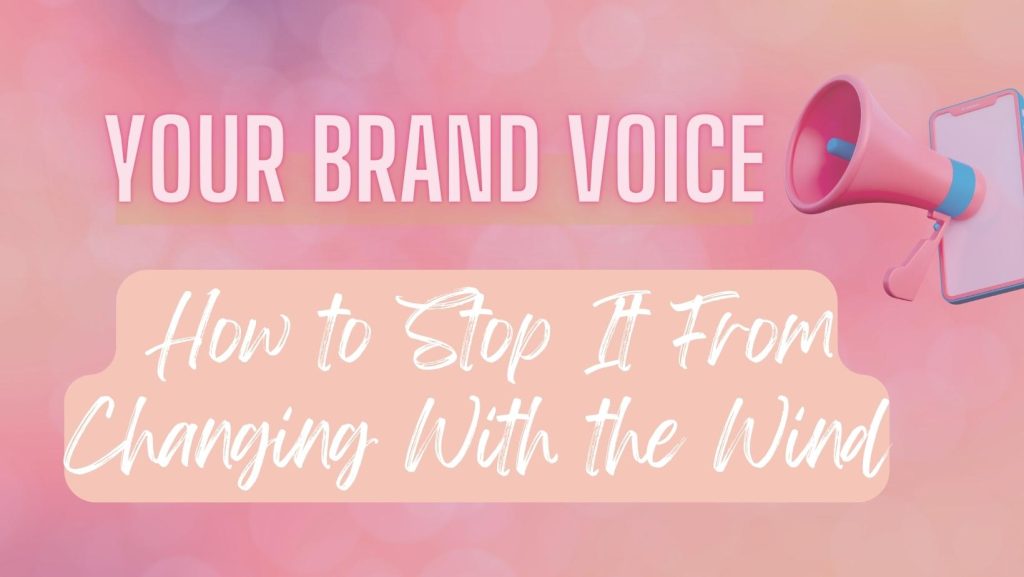Have you ever felt that a specific copywriter just knew how to capture your brand voice perfectly? Maybe they “got” your company in a way that others didn’t, and their work just had a “je ne sais quoi” that made it stand out from the rest. But then, a couple of months later, they had to stop working with you, and suddenly, your brand voice was all over the place again.
Your social media posts didn’t sound quite right, your website copy wasn’t as on-point as it used to be, and every platform felt like a different world of its own. It’s common for copywriters to come and go, but that doesn’t mean that your brand voice has to suffer as a result. In fact, having a strong brand voice is more important than ever in today’s competitive marketplace.
It isn’t only disappointing for you as a business owner to see your brand voice change with every new copywriter – it can also be confusing and off-putting for your customers. Customers want to know what to expect from your brand, and if they don’t feel like they can rely on your voice to be consistent, they may not stick around for long.
But what can you do to ensure that your brand voice stays the same – no matter who’s writing? Here are the steps to follow.
What is Brand Voice?
Let’s rewind for a minute and talk about what a brand voice actually is. Your voice is the personality of your business that comes across in your written communication – whether it’s on social media, website copy, or email correspondence. It represents the character of your company and can be thought of as its own unique type of language.
It’s what makes you unique and what helps customers connect with you on a deeper level. In other words, it’s a living, breathing part of your company that comes through in everything you do and across every touchpoint.
Defining your brand voice isn’t just a one-time exercise – it’s an ongoing process that should be revisited on a regular basis. As your business evolves, so too should your brand voice. But every time you do it, it’ll last for a lot longer than one copywriter’s tenure.
Now, let’s talk about how to make sure your brand voice remains consistent over time.
The 5 Steps to Defining Your Brand Voice
From reflecting on your company’s values to finding the right words and phrases, here are five steps to follow when defining your brand voice:
1.Reflect On Your Brand Story
Your brand story is what makes you unique and sets you apart from the competition – it’s your reason for being. How did your business come about? What inspired it? Who does it serve? How does it help people? Getting clear on your story is the first step to establishing a unique and memorable brand voice. Be sure to link the story with how it translated into your mission and vision, and you’ll have an irresistible narrative.
2. Establish Your Brand Values
Your values are the foundation of your brand – they guide you, inform decisions, and define who you are. Take some time to determine which values you want to be associated with your company, such as innovation, creativity, integrity, support, and much more. These values should be demonstrated at every level of your business, so don’t be tempted to choose what “sounds” good – they need to be genuine.
To make sure you’re not choosing these haphazardly, take the time to define each one in relation to your brand. For example, what does creativity look like for you? What do you mean by integrity? Answer these questions in detail.
3.Brainstorm a “Voicebank”
After you’ve established your brand values, it’s time to start brainstorming words and phrases associated with them. These can be used to craft consistent copy across all platforms and mediums.
For instance, if one of your core values is support, some words that come to mind are helpful, understanding, and accommodating. Keep adding to this list as time goes on – it’ll become a treasure trove of descriptive language to use in your written communication. Think about what words and phrases best capture the essence of your brand, and make sure they’re there.
You may also want to emphasize any phraseology specific to your industry or business, such as acronyms or lingo. Similarly, you can include a list of no-go words and phrases that don’t fit with your brand values.
4. Develop Your Brand Tone
Once you have your values and word bank in place, it’s time to define the overall tone of your brand voice. Your brand voice should be an extension of you, your company, and its values. Think about the tone that best reflects what your business stands for and how it’s different from other companies in the same industry.
Remember that values can be communicated in many different ways, but the tone you choose will ultimately depend on your company’s purpose, the type of customers you’re serving, and your own individual style.
For example, the “support” value can be communicated in a friendly, helpful tone or an authoritative, knowledgeable one. You’ll need to consider the types of interactions you want with customers and how your brand can best come across in those interactions.
Should the tone be light-hearted or serious? Empowering or reassuring? Engaging or informative? Once you decide on the tone, crafting copy that always hits the mark will become much easier. Just think carefully about the message you want to convey with your words and how they will make customers feel. How do you want them to talk about your business?
5. Share Your Tone of Voice Guidelines
Lastly, once you’ve established your brand voice, it’s important to document it all in a brand voice guide that everyone on the team – whether in-house or freelance – can refer to when creating content. This could include copywriters, content writers, social media managers, customer service representatives, and more.
Getting it all in writing is essential – it’ll ensure that everyone is on the same page when creating or curating content and will help you maintain a consistent tone across all channels. Plus, it won’t put you in that situation where every copywriter you hire creates copy in different styles.
Here’s a sample example of what should be included in your voice guide:
- Brand story
- Mission and vision
- Target audience (preferably an entire customer profile)
- Core values
- Tone of voice
- Word bank (including no-go words)
Of course, you can add more or less to this depending on your company’s needs. For instance, you could always add details of your brand archetype, your positioning statement, conviction codes, and any other details that may come in handy for your team.
It’s Time to Get Your Brand’s Tone of Voice Right!
Tracing back to the example of the copywriter who just “got” your brand, the secret to their success was probably that they took the time to really understand your company and what makes it unique. They didn’t try to force your brand into a predefined template or box – instead, they allowed your voice to shine through in their writing. That’s what you need to do, too, but get it in writing this time.
By taking the time and effort to create a comprehensive brand voice guide, everyone – from copywriters to social media managers to guest bloggers – will be able to understand what your company stands for, how it speaks, and how they should communicate with customers – regardless of the medium. That way, no matter who comes and who goes, your brand voice will always stay the same, and you won’t have to rework any written piece every time you make a new hire.
Finally, it’s important to remember that these guidelines don’t need to be set in stone – you should keep reviewing them regularly and update them as necessary so that your tone of voice always reflects your brand values, mission, and goals.
Your tone of voice is how you communicate with the world – make sure it’s on point!
I’ve recently added brand voice guides to my list of services. If you’re interested in getting yours created (and rightly so!), feel free to drop me a line. It’s a step in the right direction for any business that wants to ensure its message is always getting across effectively and efficiently.



